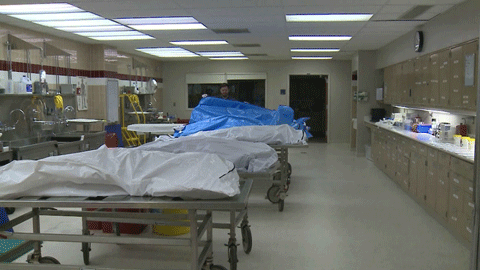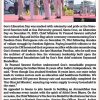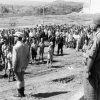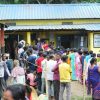Goa is abuzz with excitement as vintage bike and car owners, users, collectors and fans are decking […]

SAFAI WORKERS DO POSTMORTEMS!
Aug 21- Aug 27, 2021, INFOCUS August 20, 2021CALLOUS: Even in the Goa Medical College & Hospital’s Forensic Department a large number of dead bodies are allegedly treated with little respect. Says one GMC veteran patient, “I was traumatized when I saw how roughly the staff handled the body of a close friend of mine who expired. The dean, Dr Vinay Jindal, who was with me, was very casual, telling me that in any case my friend was dead, so it does not matter!” There is no respect for the dead either in the Forensic Department or the overcrowded morgue, where the air-conditioning comes and goes and leads to quick decomposition of loved ones!
By Rudraneil Sengupta
The in-death investigation done by the online The Wire shows that autopsies performed in government hospitals, in sensitive cases like the death of the 19-year-old girl on Calangute beach, cannot be relied upon for there is a public trust deficit
Forensic investigations in India are done by doctors who are neither trained nor qualified, leading to endless legal stalemates
At 23 minutes past noon, the second body of the day arrives, laid out flat on an open trailer harnessed to a tractor. The body is covered in a white sheet. The dead man’s name is Ram Chander: 25 years old, a labourer. He was found this morning slumped under a tree inside a primary school in his village, with a noose around his neck. Next to his body squats his father, Ram Pal, a small man with short salt-and-pepper hair tamped down on his head. Ram Pal’s eyes are closed.
As the tractor comes to a stop under a towering Seemal tree inside the district mortuary compound in the town of Barabanki, Uttar Pradesh—an hour’s drive from the state’s capital, Lucknow—Ram Pal steps off the trailer and looks around with dazed eyes. He notices a battered police car and walks up to it. From the back of the car protrudes what is unmistakably the feet of another body, wrapped tightly in a white sheet. This was the first body to arrive, at 9:37, and it belongs to a government clerk, the victim of a hit-and-run.
ATOPSIES KEY IN CRIMES
The clerk’s brother has fallen asleep under the tree. The police have not managed to get the inquest papers required for an autopsy to begin, and after three hours of restless and silent pacing, during which the clerk’s brother searched for, and failed, to find anyone to speak to about the situation, he gave up and lay down to rest. Now Ram Pal joins the wait.
At one in the afternoon, two policemen arrive with another body—a 72-year old man who died in prison while serving a life term for murder—in a ramshackle ambulance splattered with dried blood. The policemen bang loudly on the black gate that separates the parking lot from the autopsy rooms. The mortuary manager opens it a sliver to speak to the police. The families of the dead, roused by this new development, gather around. The inquest papers have come. The bodies are piling up.
The gate opens wider and Rakesh Kumar steps out. He is 45 years old, dressed in oversized red boxer shorts, a frayed t-shirt that sweeps over his belly, a thin pair of glasses with a broken bridge fixed with tape, and a pair of worn-out rubber slippers. His hair is cut close to the scalp and he has a drooping moustache.
The police know him well: he does all the autopsies. They offer him a pint bottle of whiskey and cajole him to start. He goes into the guardroom at the corner of the compound that doubles as his home, pours himself a stiff drink, drains it in one gulp, stuffs tobacco in his mouth, and pulls a pair of white rubber gloves onto his hands.
At 13:37, Rakesh has the body of the clerk laid out on the stone table in the cramped autopsy room, lit by a bright, naked bulb hanging from the ceiling. He takes a crude, rusted, knife and makes the first incision: a carefully drawn straight line—with a slight leftward deviation to bypass the navel—beginning from just under the adam’s apple, and ending just above the penis. The line splits the upper layer of the skin. Now he picks a six-inch knife, as rusted and rough as the first one, its handle held in place with a twine of blue plastic. He begins to cut through the layer of fat under the skin along the incision, and then through the flesh.
“You have to be careful, you don’t want to cut through any organs, or the post mortem will be ruined,” Rakesh says.
Rakesh is not a forensic surgeon. He is not a doctor. His official designation is ‘safai karamchari’—he is the mortuary’s cleaner. He is barely literate. Today, he will cut open six bodies, inspect them inside and out for injuries, remove the organs and weigh them before putting them back into the stomach cavity, stitch the bodies up, wrap them in plastic and a cotton sheet, and hand them back to the families.
The doctor actually assigned to do the autopsies will come in half an hour after the commencement of the first body, and will get to wear a mask, gloves, and a gown; but he will never once touch a corpse. Instead, he will observe and write his reports, often asking Rakesh to narrate what he is seeing. The doctor will leave before the last body—the prisoner—is barely open, having already written and signed the autopsy report for the old man.
In the event of an unnatural death, the autopsy or post-mortem examination of a body is an invaluable and essential tool in investigating the probable cause and manner of dying. For the police, the autopsy report forms the backbone of an investigation. For the judiciary, it is critical evidence that can, with a single conclusive expert statement—‘the probable cause of death is suicidal and homicide can be ruled out’—determine the outcome of a case.
In India, an autopsy is done for every ‘unnatural death’. This may mean murder, suicide, death from an accidental fall or drowning, death from a traffic accident, unexplained sudden deaths, any unidentified body found in any condition (including foetuses), and any hospital death where the family of deceased believes that the patient died due to negligence. The process kicks in automatically when a person dies.
NO DATA ON ATOPSIES
Though there are no figures available for the number of autopsies done in India, the National Crime Research Bureau (NCRB) does provide a figure for the total number of deaths where criminal cases were registered in 2016, excluding traffic accident casualties: 1,95,006. NCRB’s latest data on suicides is from 2015, where it recorded a total of 1,33,623 deaths.
A two-month investigation by Mint has revealed that the vast majority of this staggering number of autopsies that are performed every year are of little value, and in fact, often have the exact opposite effect of what it is supposed to: riddled with errors, or done incompetently, they lead to justice being denied. Mint spoke to doctors, forensic scientists, police officers, lawyers and judges across the country; analyzed autopsy reports, inquest reports, court judgements, post-mortem reviews, papers in medical journals, and statistics from various official sources and RTIs; and witnessed autopsies being performed at multiple mortuaries.
“An autopsy is an instrument of medico-legal investigation of death,” says Dr Sudhir Gupta, who heads the Forensic department at AIIMS, New Delhi, India’s finest forensic facility. “This is not just about cutting up a body and filing a report as a formality. But because of the sheer volume, that’s what is happening in most places.”
Dr Gupta’s colleague Adarsh Kumar, a professor of forensic medicine at AIIMS, says that roughly 80% of these autopsies are being done by doctors who have never been trained in the field.
“It is for them simply an enforced duty that needs their signature,” he says. “Because of this the problems that are created—in terms of delivery of justice, in terms of finding out what really happened to the deceased—are huge. And there are thousands of cases like that, uncountable.”
Dr Indrajit Khandekar, professor of forensic medicine at the Mahatma Gandhi Institute of Medical Sciences in Sewagram, Maharashtra, points out that there is a fundamental problem with the law (174 CrPC) that governs ‘unnatural death’ as well. Framed in the 1860s—three years after germ theory came into existence, when there was little concept of specialist doctors, and antiseptics were yet to be invented—the law simply says that the examination of the body be done by a ‘qualified medical man’.
ATOPSIES NOT RELIABLE
“
So what have the states done? They have authorized all doctors in government service—general practitioners, pediatricians, whoever—to do autopsies,” Khandekar says. “So, a person who has never done a single autopsy in training, and in many cases, have never even witnessed one in school, is expected to do it.”
The problems follow thick and fast: mortuaries without basic facilities where bodies are left to decompose, piled on top of each other, without refrigeration (many mortuaries have no access to running water or electricity). Dr Sachin Meena, assistant professor of forensic medicine at Government Medical College, Kota, in Rajasthan, describes his own mortuary as ‘hell’. In most of them, there are no protective gowns or masks (neither are bodies screened for infectious diseases), and sometimes, no gloves. Dr Dharmaraya Ingale, a forensic doctor and the principal of Karuna Medical College in Pallakad, Kerala, says that the ten years he spent as a medical officer in the district of Bijapur in Karnataka were like a ‘nightmare’, where he was forced to do autopsies in the open, next to a water body, since the mortuaries had poor lighting lacked running water. “When there were no gloves, we found discarded plastic packets to wear on our hands,” he says. “Nothing has changed.”
NO FORENSIC TRAINING
Why is it that most autopsies are done by doctors not qualified to do it? The answer is absurdly simple: The MBBS graduates and non-forensic specialists entrusted with doing post-mortems in India are never made to do an autopsy during their training.
Dr Khandekar, who filed a PIL on forensic curriculum in 2014 after collecting data and teasing information out of the Medical Council of India (MCI, which sets the curriculum for medical education) via RTIs, says that in the MBBS course, forensic post-mortems is the only clinical discipline that does not have a prescribed practical teaching schedule, practical examinations, or a clinical posting for internship.
“The only thing mandatory in forensic studies is that you write a theoretical exam,” Khandekar says. It’s the equivalent of someone becoming a surgeon simply by reading a book, without ever having to hold a scalpel.
For doctors graduating from some government medical colleges, the only requirement is to simply observe 10 autopsies being done. Most doctors I spoke to said that they either did not get, or chose not to attend, even those ten during their schooling. In private medical colleges, which are not authorized to do autopsies in any state except for Karnataka and Puducherry, even this basic minimum is missing.
NO FORENSIC EXPERTS
Some states, like Uttar Pradesh and West Bengal have even stranger rules: in both these states, the forensic departments in even government medical colleges are not authorized to do autopsies. Only government medical officers—a tiny fraction of whom are forensic specialists—are allowed to do it. (The rule is exactly the opposite in Delhi, which has some of the best practices and infrastructure in place for post-mortems, and where only forensic doctors handle the cases.)
“So here you have a situation which makes no sense at all,” says Dr Jagadeesh N Reddy, professor of forensic medicine at Vydehi Medical College, Karnataka. “You have forensic specialists training budding forensic specialists, but neither the teachers nor the students ever do a single autopsy, which, in turn, is being done by a doctor who has no training in it.”
“You know the phrase, ‘what the mind does not know the eyes cannot see?’” Dr Sudhir Gupta asks me in his office at AIIMS, New Delhi.
That is what is happening with forensic investigations in India. The infrastructure is completely inadequate, there are no uniform guidelines, the training is not there, and there is no provision for trained assistants in a mortuary, and no assessments. Compare that to an Operating Theatre, which is ruled by strict guidelines, and is subject to assessments all the time. We have a moral, medical, and legal obligation to change this.”
BONES ENOUGH TO CONVICT
When Dr Sudhir Gupta stood over the collection of bones that were suspected to be the mortal remains of a young woman called Sheena Bora, he thought of the bones of birds that fly long distances. He thought of the time he had read about the Sushruta Samhita, the ancient Indian text on medicine and surgery, where the bones of migratory birds were heat-tempered to make the fine, tough, two-sided blade of a lancet.
This set of bones he was looking at, they belonged to a body that had been set on fire. He could see the charring. The murderer or murderers had burnt the corpse to conceal the identity of the victim in case the body was found. They had made a mistake. The heat had tempered the bones and made them tough. Even though they had been dug up on a rainy afternoon from a hidden grave inside a forest off the highway that goes from Mumbai to Goa, where they had spent three years buried in a hot and humid place, the bones were perfectly preserved.
“The burning had heat-tempered and made the bones decomposition-proof,” says Dr Gupta, head of the department of forensics at AIIMS, New Delhi. “Otherwise, bones decompose significantly within a year and a half, and our work would have been much harder.”
Yet, in his three decades as a forensic specialist, this was one of the biggest challenges he had ever faced—to find some clues that can shed some light on a murder that took place three years earlier from nothing more than skeletal remains.
The facts of the case, in a nutshell, were this:
A driver called Shyamvar Rai was arrested in 2015 by Mumbai Police for the possession of illegal firearms. Rai cut a deal with the police: he would reveal to them his role in a murder in 2012 that the police did not even know about, in return for a lenient sentence. Rai told the police that on April 24, 2012, when he was working for Indrani Mukerjea and her husband Peter Mukerjea, well-known media moguls based out of Mumbai, he was roped in by Indrani to help her murder her estranged daughter from an earlier marriage, a 25-year-old woman called Sheena Bora. Rai told police that Indrani drugged Bora in the backseat of the car as he drove them around Mumbai, before strangling her to death. The next day, Indrani asked Rai to drive her to a predetermined spot along the Mumbai-Goa highway with Bora’s body, where they set the body on fire and then buried the remains.
A month later, a man living in a village near the spot where the body was buried accidentally stumbled on the skeletal remains. A spot post-mortem was done by a doctor with the help of the local police, some bone samples were collected and sent to Mumbai’s JJ Hospital, and the rest of the skeleton was reburied at the same spot. Nothing else happened in the case. The body could not be identified, and no cause of death could be determined. It was not until Rai’s confession in 2015 that police could connect the unknown body from 2012 to Sheena Bora. The skeletal remains were dug up again for a fresh forensic examination and sent to Dr Gupta and his team to establish the identity of the exhumed skeleton.
The team at AIIMS first identified if the bones were human or not. Then they carefully inspected each bone for any signs of injury—was this person stabbed? Shot? Assaulted with a blunt object? They tried to fix the time of death, which required state of the art chemical analysis techniques. Then they began to reconstruct the bones in their normal anatomical arrangement, and with the help of cutting-edge imaging, and DNA and tissue analysis, began to form an idea of the height, weight, sex, and probable physical features of the person when she was still alive. The results were a close match to Bora. They found a particular kind of filling in a tooth and asked the CBI to match it with Bora’s dental records. It was a match, as was the DNA with the DNA taken from Indrani.
“It took us a whole month,” says Dr Gupta. “And at the end of it, we gave the CBI three opinions in our report: That this body is probably of Sheena Bora; that she probably died these many days ago; and that the body showed no signs of external injuries, which meant she could have been killed by strangulation.”
This is an example of an ideal autopsy, performed by a team of experienced and well-trained forensic specialists with access to a great amount of resources. It is also an example of the power the idea of an autopsy holds for the police, the judiciary, as well as governments: that it can reveal everything about the death of a person.
“There are many limitations to what you can find from an autopsy,” Dr Gupta says. “And it is the need of the hour for all stakeholders, especially the judiciary and the police to try and understand the limitations of post mortem examinations and what they can expect from it.
“It took us a whole month,” says Dr Gupta. “And at the end of it, we gave the CBI three opinions in our report: That this body is probably of Sheena Bora; that she probably died these many days ago; and that the body showed no signs of external injuries, which meant she could have been killed by strangulation.”
This is an example of an ideal autopsy, performed by a team of experienced and well-trained forensic specialists with access to a great amount of resources. It is also an example of the power the idea of an autopsy holds for the police, the judiciary, as well as governments: that it can reveal everything about the death of a person.
ENGINEERED TO FAIL
“Is it possible for a single doctor to examine and dissect even 6 or 7 bodies in a single day?” Asks Dr Reddy. “Impossible. But that’s what is happening now. The system is engineered to fail.”
Instead, doctors suggest, a simple screening method will rule out the need to do an autopsy in a very large number of cases, a decisive example being victims of traffic accidents who are brought to hospitals alive but die subsequently—a group that accounts for nearly a third of the roughly 7 lakh autopsies done in India every year.
Khandekar shows me the death certificate of a man who was admitted to a major government hospital in Nagpur on the first of October, 2017, with a severe head injury after a bike accident. After multiple surgeries, the patient died of his injuries on 18 January, 2018.
“And yet, this certificate says, ‘cause of death to be decided after post-mortem,” Khandekar says. “If a patient is under your care for 3 months, and you have done multiple surgeries, tests, scans, and still you need an autopsy for cause of death, what is the use of you being a doctor? Or do we just like dissecting bodies? What can you find by opening the body which you did not find in your full CT scan?”
The burden of doing a clearly unmanageable number of autopsies makes the system profoundly ineffective, leading to vicious practices like making sanitation workers perform autopsies, most often without basic safety measures.
Excerpts from article on shoddy post mortems which let many criminals escape particularly in dowry death cases and caste atrocities.
Coutersy www.livemint.com















